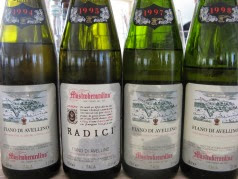The Mastroberardino family for over two centuries deals with wine.
The first evidence of the presence in Irpinia date back to the Land Registry Bourbon, in the middle of the eighteenth century, a time when the family chose the village in the province of Avellino Atripalda their headquarters, where they are still located on the old cellars, and there originated in offspring that their fate inextricably tied to the cult of the wine. Since then I have spent 10 generations that have carried on the business of the family of origin ups and downs: the phylloxera, the first and the second world war that depopulated the countryside and the earthquake that struck so disastrously in the 70 territory.
The first evidence of the presence in Irpinia date back to the Land Registry Bourbon, in the middle of the eighteenth century, a time when the family chose the village in the province of Avellino Atripalda their headquarters, where they are still located on the old cellars, and there originated in offspring that their fate inextricably tied to the cult of the wine. Since then I have spent 10 generations that have carried on the business of the family of origin ups and downs: the phylloxera, the first and the second world war that depopulated the countryside and the earthquake that struck so disastrously in the 70 territory.
"We defended our traditions and our tastes gaining recognition worldwide. Pliny spoke of Fiano and Falanghina in these areas, we fought to preserve the history" was use to tell to those who visited the winery Antonio Mastroberardino, the guru of wines from Campania, who died last January aged 86.
It 'about her though many winemakers have retained the Irpinia Aglianico vines, Taurasi, Fiano and against any Greek fashion, against any approval of taste would say almost ahead of its time, at a time when the Ministry of agriculture pushed to replace old varieties with more productive, Trebbiano and Cabernet.
I tasted it for the first time in 1978 a wine Mastroberardino Taurasi.
It was a red that I did not expect to find in central Italy because of ignorance and inexperience assimilated all the red wines produced in those areas at that time were mostly Apulian wine rosé wines, high alcohol content and not full-bodied. Over time I learned to appreciate even the excellent white wines, Greco, Greco di Tufo and Fiano. The list of course does not end there because the family is large and there are many estates, including a recent (2008) at Apice, a place famed in antiquity as fruit and vegetable market, and the different wines.

 From this project came the red wine Villa dei Misteri, made from grapes of Piedirosso (90%), already known at the time of Campania felix decantatato of Horace and Pliny in his Naturalis Historia, and Sciascinoso (10%), red grape of Campania known with the name of Olivella for the berry shape that reminds the olives and that probably coincides with the oleaginea described by Pliny. This vine is present in Campania for so long that they can rightly be termed native. The collaboration with the Superintendent Mastroberardino is continuing successfully. In fact the company is catching up other spaces in the city such as the Garden of the Fugitives where it was now planted a vineyard Aglianico.
From this project came the red wine Villa dei Misteri, made from grapes of Piedirosso (90%), already known at the time of Campania felix decantatato of Horace and Pliny in his Naturalis Historia, and Sciascinoso (10%), red grape of Campania known with the name of Olivella for the berry shape that reminds the olives and that probably coincides with the oleaginea described by Pliny. This vine is present in Campania for so long that they can rightly be termed native. The collaboration with the Superintendent Mastroberardino is continuing successfully. In fact the company is catching up other spaces in the city such as the Garden of the Fugitives where it was now planted a vineyard Aglianico.
I tasted it for the first time in 1978 a wine Mastroberardino Taurasi.
It was a red that I did not expect to find in central Italy because of ignorance and inexperience assimilated all the red wines produced in those areas at that time were mostly Apulian wine rosé wines, high alcohol content and not full-bodied. Over time I learned to appreciate even the excellent white wines, Greco, Greco di Tufo and Fiano. The list of course does not end there because the family is large and there are many estates, including a recent (2008) at Apice, a place famed in antiquity as fruit and vegetable market, and the different wines.

One of the most interesting projects is the project the Villa of the Mysteries, in collaboration with the Archaeological Superintendence of Pompeii, which has entrusted in 1996 to Mastroberardino the task of restoring the viticulture in the ancient city.
Before the eruption of Mount Vesuvius that destroyed, we know from archaeological finds in Pompeii Grapes were grown in the gardens and orchards even within the walls and that there were flourishing vineyards. Botanical studies and the collection of casts of the roots of the vines and the supporting posts have allowed us to understand a lot about local viticulture at the time. View Company Mastroberardino.
Before the eruption of Mount Vesuvius that destroyed, we know from archaeological finds in Pompeii Grapes were grown in the gardens and orchards even within the walls and that there were flourishing vineyards. Botanical studies and the collection of casts of the roots of the vines and the supporting posts have allowed us to understand a lot about local viticulture at the time. View Company Mastroberardino.
 From this project came the red wine Villa dei Misteri, made from grapes of Piedirosso (90%), already known at the time of Campania felix decantatato of Horace and Pliny in his Naturalis Historia, and Sciascinoso (10%), red grape of Campania known with the name of Olivella for the berry shape that reminds the olives and that probably coincides with the oleaginea described by Pliny. This vine is present in Campania for so long that they can rightly be termed native. The collaboration with the Superintendent Mastroberardino is continuing successfully. In fact the company is catching up other spaces in the city such as the Garden of the Fugitives where it was now planted a vineyard Aglianico.
From this project came the red wine Villa dei Misteri, made from grapes of Piedirosso (90%), already known at the time of Campania felix decantatato of Horace and Pliny in his Naturalis Historia, and Sciascinoso (10%), red grape of Campania known with the name of Olivella for the berry shape that reminds the olives and that probably coincides with the oleaginea described by Pliny. This vine is present in Campania for so long that they can rightly be termed native. The collaboration with the Superintendent Mastroberardino is continuing successfully. In fact the company is catching up other spaces in the city such as the Garden of the Fugitives where it was now planted a vineyard Aglianico.


No comments:
Post a Comment